عمارة القاهرة الإسلامية -
من القرن السابع حتى القرن الثامن عشر
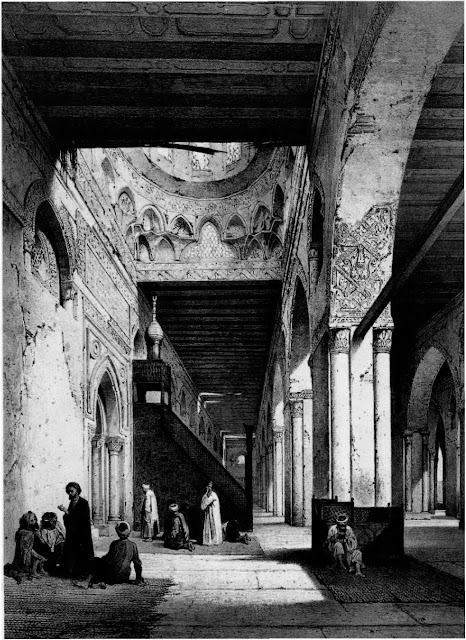
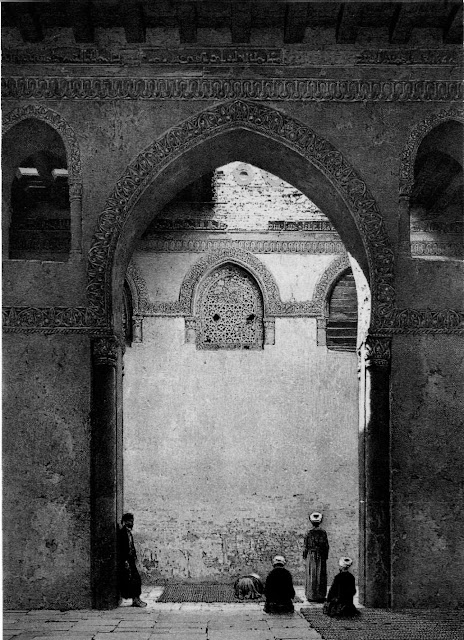
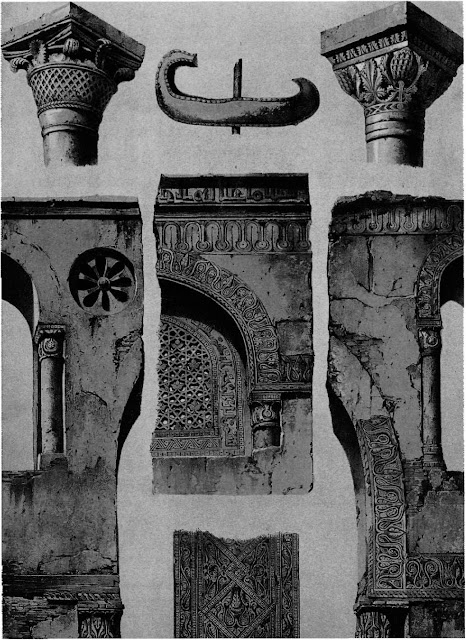
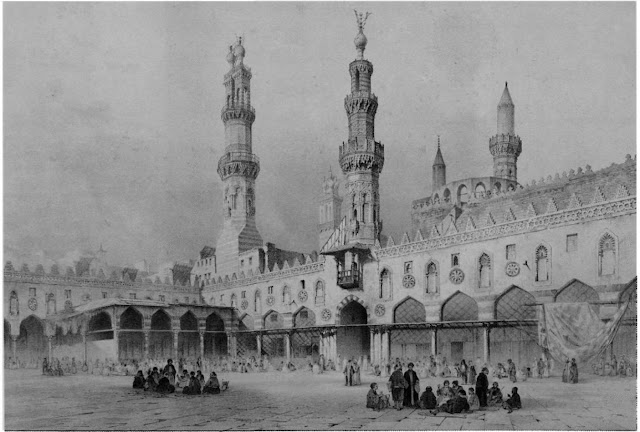
![Tala'i Abu Reziq mosque, elevation and details, 12th century. Little beyond Posse's details, elevation, and plan have survived except "the planks [on which Imam Husayn's body was bathed] embedded above the middle arch of the maqsura [traditionally engraved and ornamented], which have never borne inscriptions."](https://lh6.ggpht.com/-miiDTUZLKXE/TxLTo1ug38I/AAAAAAAAPIY/1AzEoN6hvhY/image013.jpg?imgmax=640)
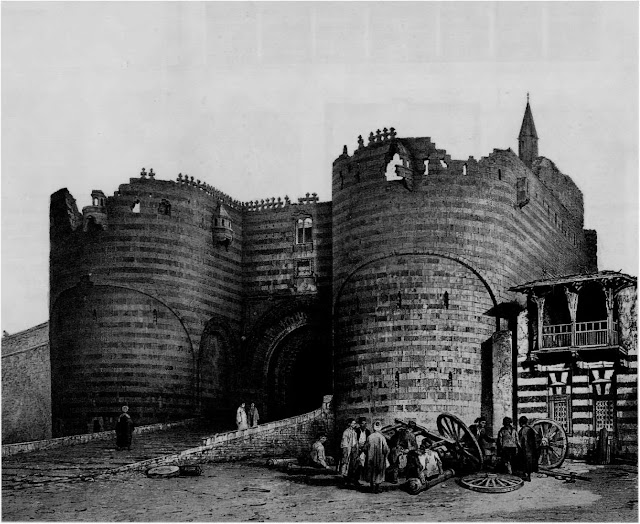

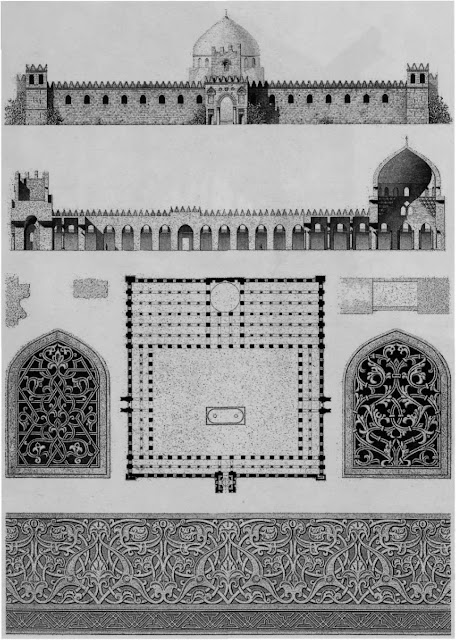
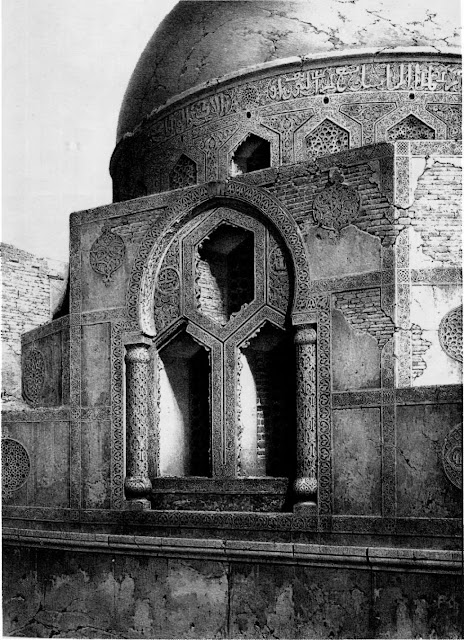
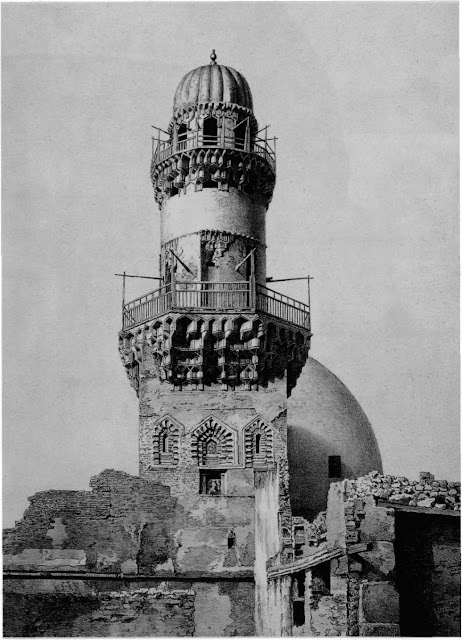
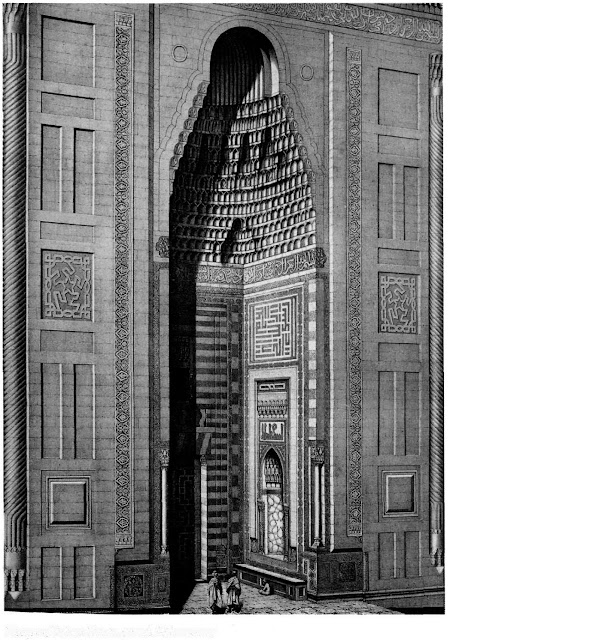
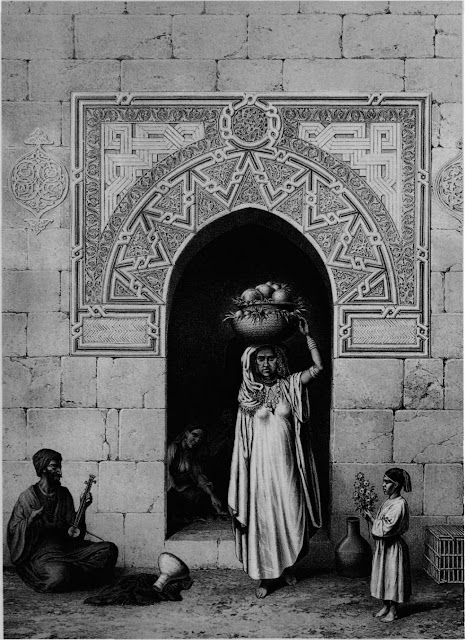
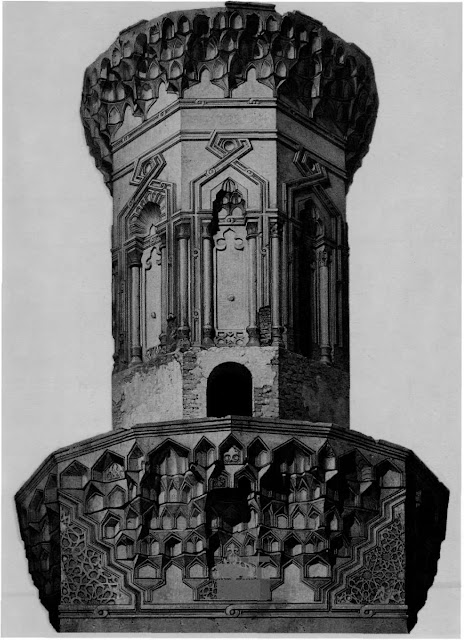

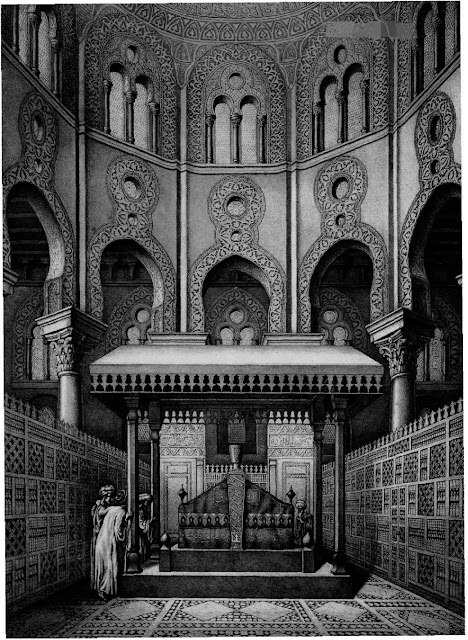
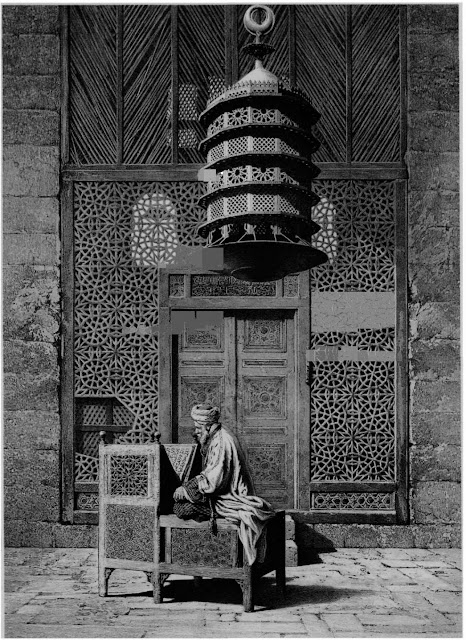


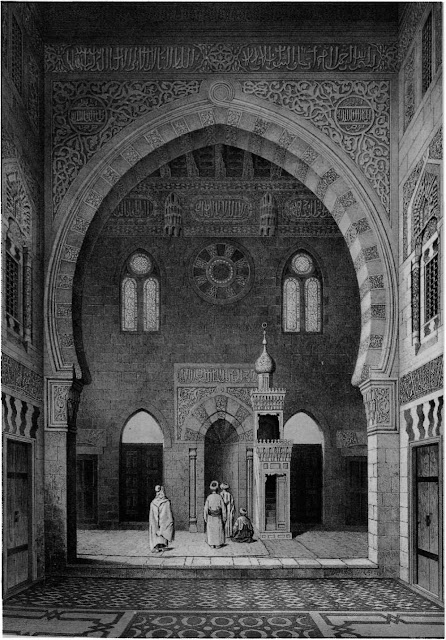

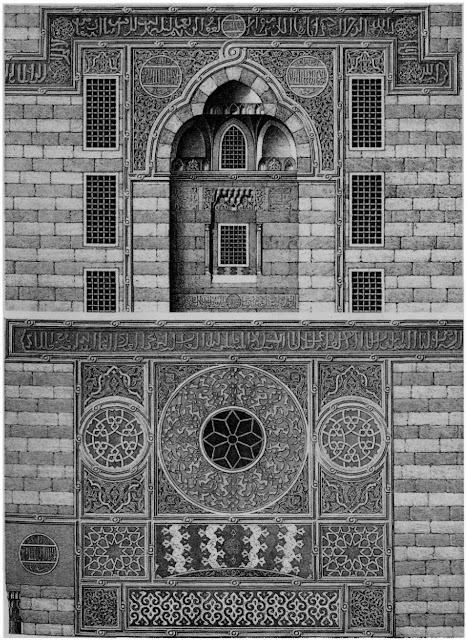
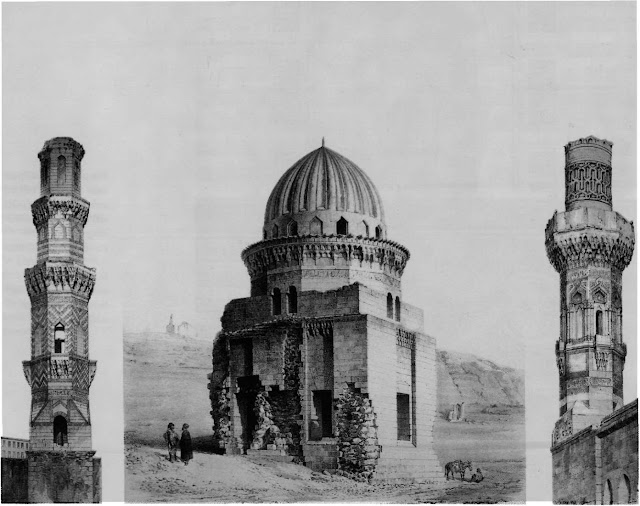
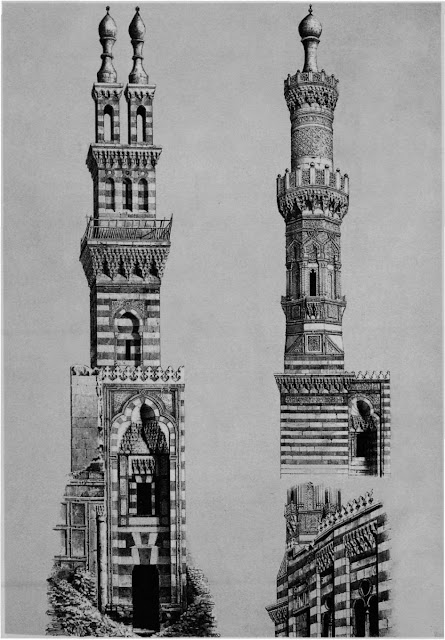
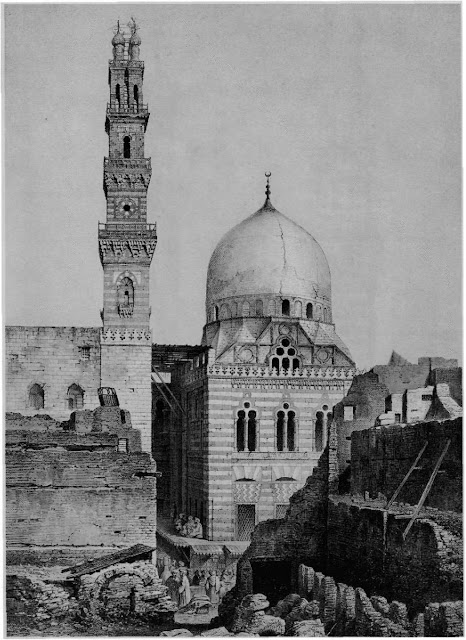
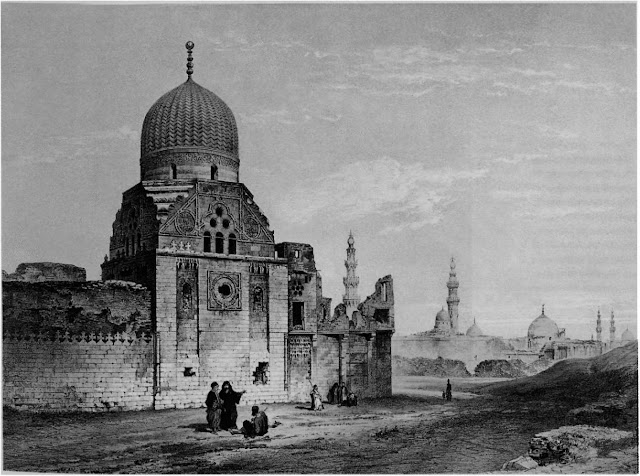
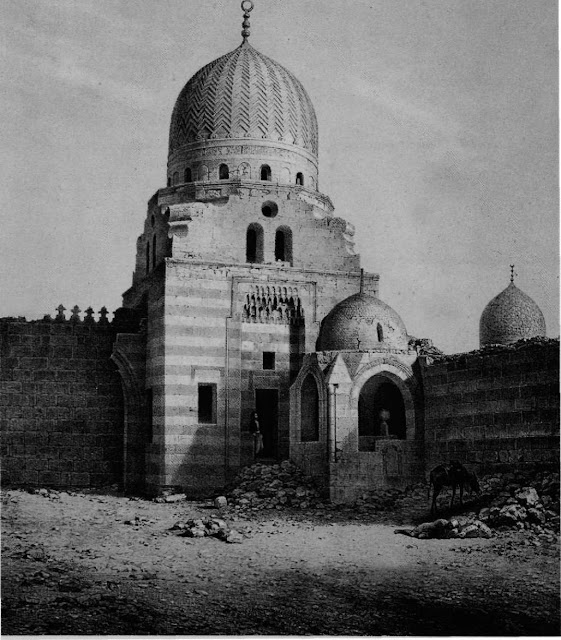
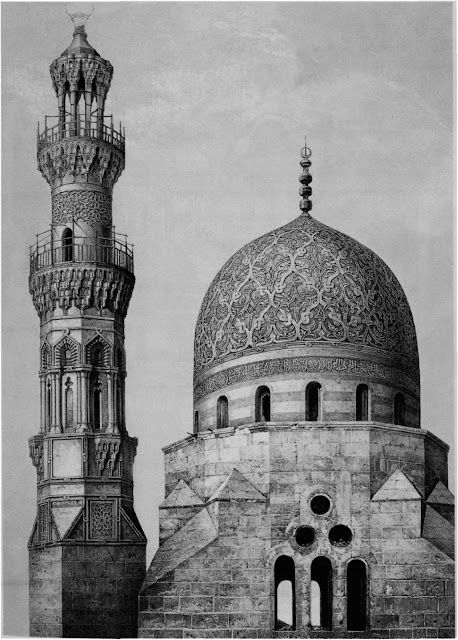
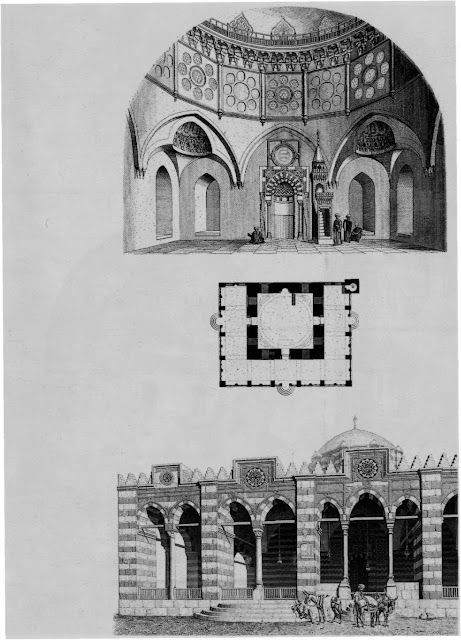
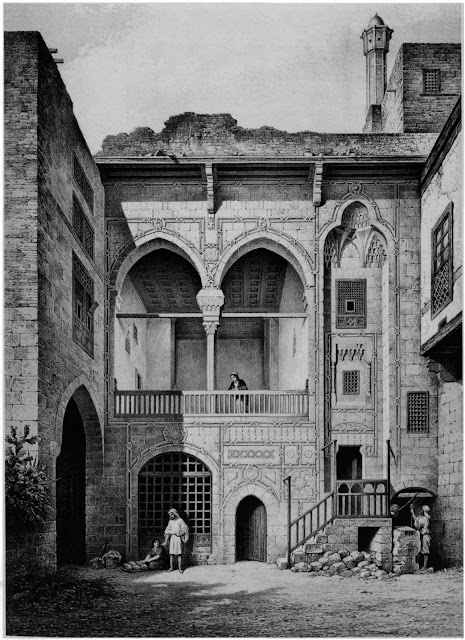
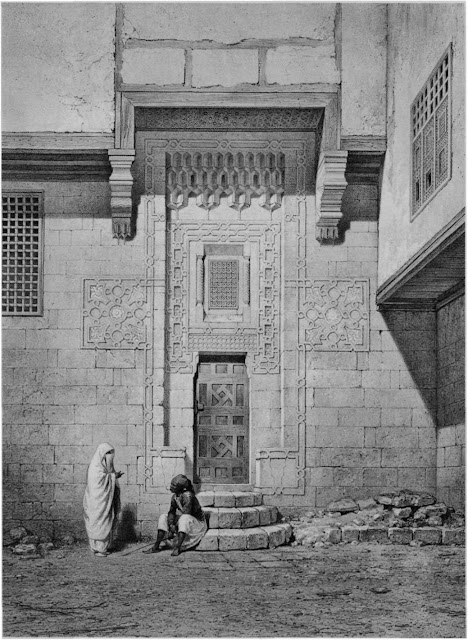
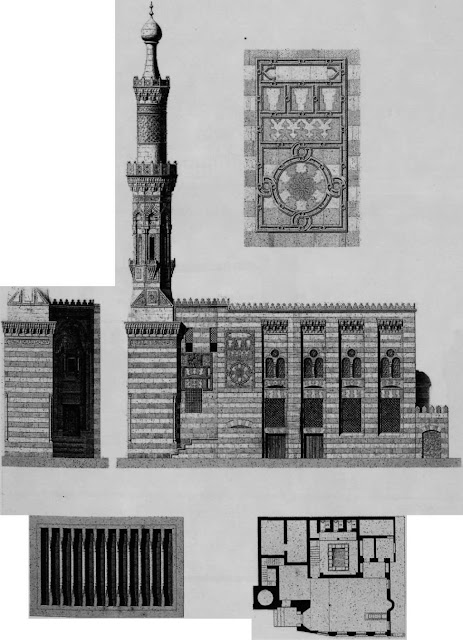

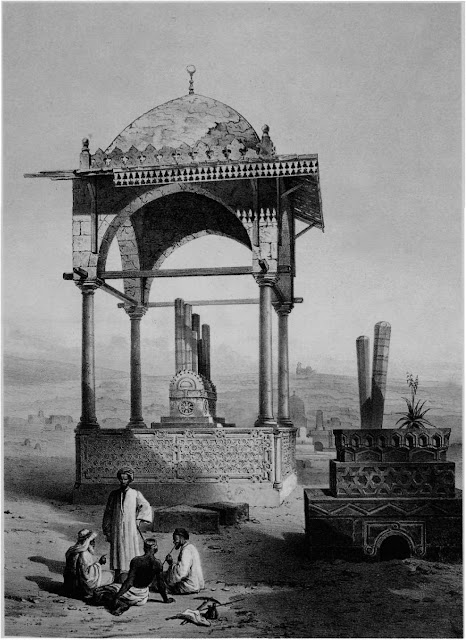
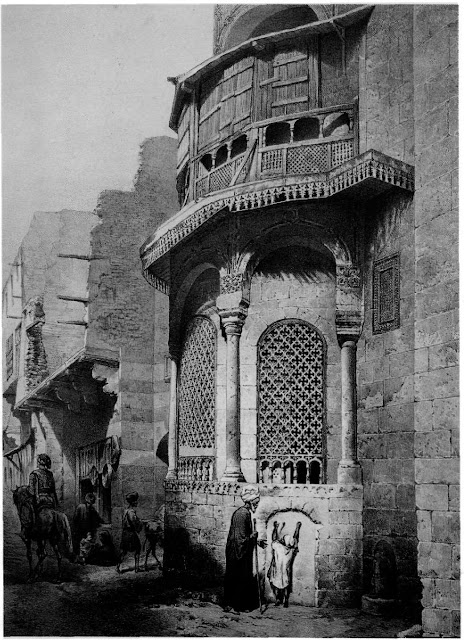



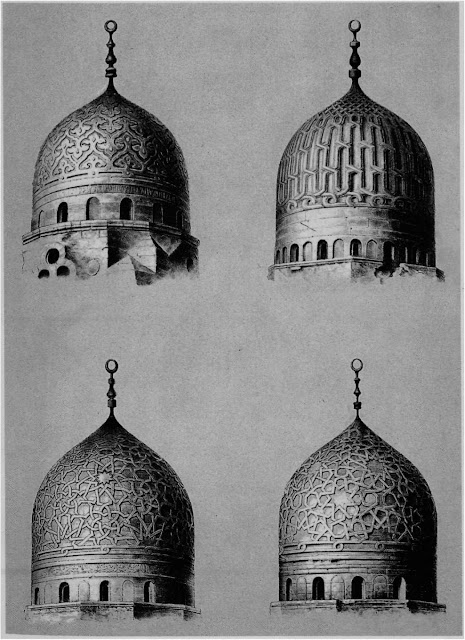

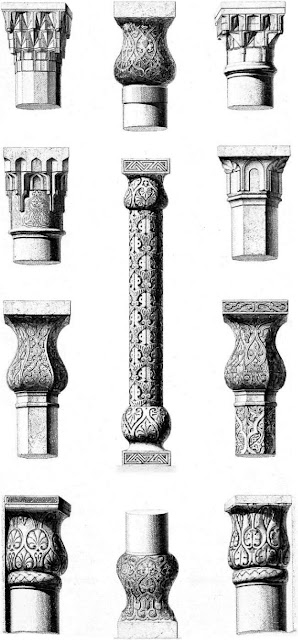
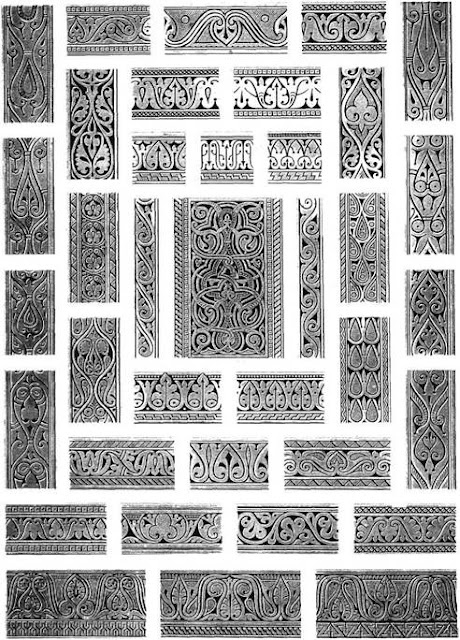
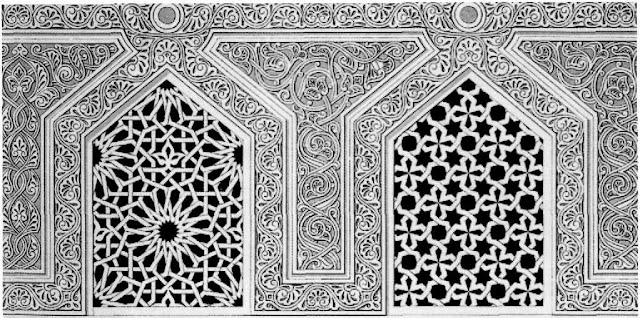
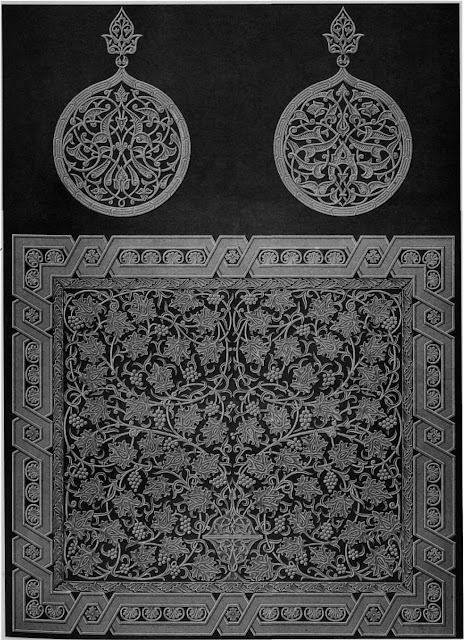
من القرن السابع حتى القرن الثامن عشر

Mosque of Ali mad ibn Tulun,
interior of the maqsura, 9th century. Gypsum and ash pillars accentuate
the domed mihrab. The mosque, inspired by the great mosque of Samarra in
the patron’s homeland, accommodated a burgeoning population of troops.
The decaying ornament in the arch’s soffit no longer exists.

Mosque of Ahmad ibn Tulun,
arcade and interior windows, 9th century. Prostrating men provide scale
and accentuat the arcade’s massiveness. Arches vary Irttle; they rest on
brick pillars with a rectangular plan. Unobstructed interior windows
and laced exterior windows form interesting contrasts, capturing the
movement of air and light.

Mosque of Ahmad ibn Tulun,
details, 9th century. Prisse contrasts the interior arched spandrels
with the decorated arches of the courtyard, which display a broad frieze
of stucco rosettes. Stucco- work frames the windows distributed around
the whole building. According to Prisse. these helped disburse
fragrances of ambergris into the congregation.

Al-Azhar mosque, main
courtyard, 10th-18th centuries.Students congregate around columns,
highlighting the mosque’s function. Prisse’s focus on the structure as
one adjusted and renovated through various epochs provides insight into
the evolution of Cairo and the position of theological, scholarly
activity in the cityscape.
![Tala'i Abu Reziq mosque, elevation and details, 12th century. Little beyond Posse's details, elevation, and plan have survived except "the planks [on which Imam Husayn's body was bathed] embedded above the middle arch of the maqsura [traditionally engraved and ornamented], which have never borne inscriptions."](https://lh6.ggpht.com/-miiDTUZLKXE/TxLTo1ug38I/AAAAAAAAPIY/1AzEoN6hvhY/image013.jpg?imgmax=640)
Tala’i Abu Reziq mosque,
elevation and details, 12th century. Little beyond Posse’s details,
elevation, and plan have survived except “the planks [on which Imam
Husayn’s body was bathed] embedded above the middle arch of the maqsura
[traditionally engraved and ornamented], which have never borne
inscriptions.”

Bab al-Azab, main gate of the
Citadel, 18th century. Radwan Katkhuda’s 18th-century addition to the
Citadel provided a stage for the decisive event orchestrated under the
pretense of a feast in 1811. Muhammad Ali Pasha invited all the Mamlukes
(elite slave- soldiers) in Egypt to the fortress and had them
massacred.

Entrance to the palace of
Sultan Baybars, 13th century. Prisse intended to convey the nature of
princely dwellings in this period when peace was fragile and the state
apparatus vulnerable to sedition. The palace’s position between the
citadel and the city provided a strategic buffer.

Al-Zahir mosque, plan,
elevation, & details, 13th century. Although the mosque was already
in ruins by the time of Napoleon’s expedition, Prisse, inspired by the
remnants, proposed layout schemes and parallels the fine decoration with
that of its contemporary, Granada’s Alhambra.

Tekiyat al-Shaykh Hasan
Sadaqa, 16th century. Sultan Selim added the 16th-century tekiya to a
14th-century mosque to house Mawali Sufis. The structure’s silhouette is
delineated by the dome, which nests on a cubical base, The large
circular interior was used by whirling dervishes.

Baybarsiya mosque, minaret,
14th century. The mosque, patronized by a former slave of Qalawaun, is
the oldest standing khanqa in Cairo. Its minaret once towered over
suirounding structures. The complex’s waqf document has survived and
offers insights into the daily life of 14th-century Sufis.

Mosque of Sultan Hasan,
porta!, 14 th century. The mosque’s portal is remarkable as an
architectural system. The artist has explored it as a functioning
independent feature and as part of the building. Columns framing inset
arches support intricate cascading muqarnas that seemingly support a
fluted half- dome.

Door of a house on Sha’arawi
Street, 14th century. Popular tradition makes this door part of a qadi’s
house. Ornament was used to forge a spandrel¬like structure; this
architectonic device is traced by knots. Domestic architecture provides
insight into popular designs similar to heraldic symbols in impenal
architecture.

Mosque of Muhammad ihn
Qalawaun, view of the minaret, 14th century. Muqamas adorning the
mosque’s minaret elevate it into the cityscape. The minaret positions
the complex on a main avenue of medieval Cairo. Recessed panels, traced
by a knotted motif and false columns, distinguish the octagonal trunk

Mosque of Muhammad ibn
Qalawaun, details of the minaret, 14th century. The plate captures
intricate details of the minaret: laced, carved- stucco arabesques and
calligraphic inscriptions that draw connections with designs visible in
the interior, specifically around the mihrab.

Mausoleum of Sultan Qalawaun,
14th century. The mausoleum’s symmetrical floor designs and intricate
woodwork ground the gaze, while the floor and square pillars, like a
swath of light, draw the eyes upward. The octagonal drum, composed of
two pairs of piers alternating with two pairs of columns, reflects a
debt to the Dome of the Rock,

Mausoleum complex of Sultan
Barquq, door to the tomb, 14th century. The northern mausoleum, intended
for Barquq and his son Faraj, is entered through wooden lattice
screens, in front of which sits an intncately carved Quran stand. Carved
wood is set against austene

Religious-funerary complex of
Qaitbay, 15th century. At this point Cairo architectural programs were
guided by interest in fundamental Mamluke architectural forms. Balance
was conferred on an angular, seemingly asymmetrical complex by details
such as the intncate carvings on the minaret and dome.

Mosque of Qaitbay, elevation
of one side, 15th century. Symmetry is not found in the mosque layout
but in the overall impact of its decoration. A lofty portal adorned with
polychrome dadoes, columned recesses, and intricate stucco carving,
frames the door that leads to the tomb. A continuous band of calligraphy
integrates the designs.

Mosque ofQaitbay, elevation
of the mihrab side, 15th century. The massive horseshoe arch framing the
mihrab suggests an unlikely airiness in this medium- sized mosque. The
qibla wall is austere, placing emphasis on its calligraphy.

Mosque of Qaitbay, ensemble
& details of the minaret, 15th century. The elegantly carved minaret
of Qaitbay’s complex displays an aesthetic more concerned with
cylindrical movements than most Mamluke minarets, which relied more
heavily on cubical base forms. Columns, used to further elevate the
structure, add lightness to its form.

Sabil Qaitbay, near Rumayleh,
part s of the facade, 15th century. This sabil on Saliba Street dates
to 1479. A trilobed arch surmounts the portal and an unusual medallion
design surmounts the iron-grated front windows that characterize sabils.
A band of calligraphy, indicated in both details, hints at the
building’s design program.

Minarets ofTurab al-lmam
mosque, 15th century, and Qalmi mosque, 16th century. This comparative
examination of the minaret of Turab al-lmam mosque and the minaret of
the Qalmi mosque reveals that both were based on an octagonal plan and
both had similar muqamas designs.

Minarets of Qanibay al-Rammah
at Nasiriya mosque, 15th century & al-Burdayni mosque, 17th
century. Contrasting minarets, cubical and cylindrical— both have
tnlobed arches, muqarnas, and alternating vertical and horizontal
voussoirs. The Nasiriya minaret exploits alternating voussoir designs
featured in the portal frame, whereas the al-Burdayni mosque displays
intricate carvings.

Mosque and mausoleum of
Sultan Qansuh al-Ghuri, 16th century. This view highlights the
mausoleum’s dome and mosque’s minaret, which crown the mercantile area
below. The double- bulbed minaret, not part of the original structure,
was inspired by minarets from the mosques of Qanibay al-Rammah as well
as al-Ghuri at al- Azhar.

Mausoleum of Emir Tar abay
al-Sharifi, 16th century. This depiction alludes to a larger complex.
The artist has articulated the dome’s double-leaf cresting, three arched
panels surmounted by windows in the form of three oculi, and the
shoulder that decorates the transition zone.

Mausoleum of Emir Mahmud
Janum, 16th century. Prisse focused on this tomb because to his mind the
adjoining mosque bore no distinguishing features, whereas the tomb
abided wholeheartedly with prevailing Mamluke conventions. Bichrome
masonry work integrated the tomb with the whole complex.

Dome and minaret of
Khayr-Bek, 16th century. Prisse discusses this essentially Mamkike
design as an anomaly. Although Emir Khayr-Bek betrayed Sultan al-Ghuri
and cooperated with the Ottomans, for which he was favored with the
governorship of Egypt, opportunism did not Override his aesthetic
sensibilities,

Mosque of Sinan Pasha,
elevation & plan, 16th century. Prisse’s elevations and plan of the
mosque of Sinan Pasha convey the Ottoman impact on Egyptian
architecture. He dendes self-conscious designs that boast magnificence,
highlighting the structure’s squatness and the lack of relationship
between prayer hall and sahn.

Bayt al-Emir,courtyard, 17th
century. Prisse, intngued by social history, has captured the heart of
Bayt al-Emtr— the courtyard. He examines degrees of privacy through
emphasis on several key features: the central grid window, evocative of a
sabil facade; the arch-lined hall above: and the mashrabiya coverings.

Bayt al-Emir, outer door to
the harem, 17th century. As pointed out by Prisse, harem entrances,
although elegantly adorned by carved geometnc designs and muqamas, are
quite modest so as not to invite strangers into this private space, This
depiction includes a guard, presumably a eunuch to protect the
inhabitants.

Mosque of Shaykh al-Burdayni, elevation, details, & plan, 17th century.

Funerary mosque near Kiman
al-Jiyushi, 18th century. This mosque shows how various edifices were
grouped around tombs. The facade shows a small room where travelers and
passers-by could stay or rest Next to the tomb, crowned by a pyramidal
dome, is a sabil-kuttab—a school and cistern.

Tombojan emir in the Qarafa
cemetery, 18th century. This tomb in the southern cemetery (Qarafa) is
defined by its elegant columns and light dome which effects airiness and
modesty. The canopied dome is typical of tombs that from the Mamluke
period onward could be purchased ready-designed.

Sabil Ahmad Husayn Marjush,
18th century. Typical of its genre and time, this sabil adheres to
Prisse’s formulaic model for sabil layout. The sabil, an institution
integral to the community as a source of water, juts into the street,
revealing its presence to the passerby.

Zamyat Abd al-Rahman
Katfchuda, 18th century. In 1729. Abd al-Rahman Katkhuda built a zawiya—
housing for Sufis—on two levels above a few shops. This was but one of
his contributions to Cairo’s cityscape. Prisse draws parallels between
its decoration and that of European Renaissance styles.

Door of the bath Hammam
al-Talat, 18th century. This delightful rendition of the door to Hammam
al- Talat located in the medieval Jewish quarter reveals an original
approach to design. A stone chain, chiseled out of limestone, seems to
have included a hook-like fixture for a hanging lamp.

Bayt al-Shalabi, courtyard,
18th century. With Prisse’s focus on details at multiple depths. The
complexities of domesticity emerge. Private and public space are
explored wrth social constructs that position people in the building:
male servants busy themselves on the ground, a female servant looks on
from above, while cloistered ladies are presumably hidden behind the
mashrabiya.

Domes: Although Prisse
attributes stylistic significance to domes, he treats them randomly and
not as reflective of transfers and adaptations of building technology.
These four designs, though essentially linear, embody dense, fleshy
arabesques typical of later Mamluke domes.

Stone as opposed to brick is
the underlying theme in this set of domes. The central dome displays an
interpretation of functional brick ribs into architectonic stone ones.
Further developments, particularly zigzagged designs, lighten solid
stone ribs with changes of direction at vertical joints, (9) Sultan
Barsbay, Khanqa mausoleum (1432): (10) Emir Qunqmas (1506); (I I)
Emirlnal al-Yusufi (1392-93); (12) Emir Ganibak at the madrasa
(1426-27); and (13) Khanqa of Faraj ibn Barquq (141 I).

Columns & pillars,
ensemble & details. Columns and pillars serve a universal function
but bear vaned ornamentation. Often removed from one building to be used
in another, they could be a key medium for transmitting designs, an
attractive idea when materials like marble were not available locally.

Mosque of Ahmad ibn Tulun,
ornamental details, 9th century. Three distinct patterns taken from
Samarra are combined and mixed, providing schemes of ornament that frame
arches and decorate soffits. Central are pointed leaves, some of which
blossom into a trefoil, and short thick undulated stems which converge
at the top.

Fragments of the dome’s exterior ornamentation

Bayt al-Emir, crowning of the
bath door, 17th century. Despite its decay, in Prisse’s time this
exhibited remnants of two different illuminated designs. The vine leaves
emerging from the vase appear to have been gilded. Elsewhere the leaves
were pale green, vine branches dark green, and grapes blue.
ليست هناك تعليقات:
إرسال تعليق